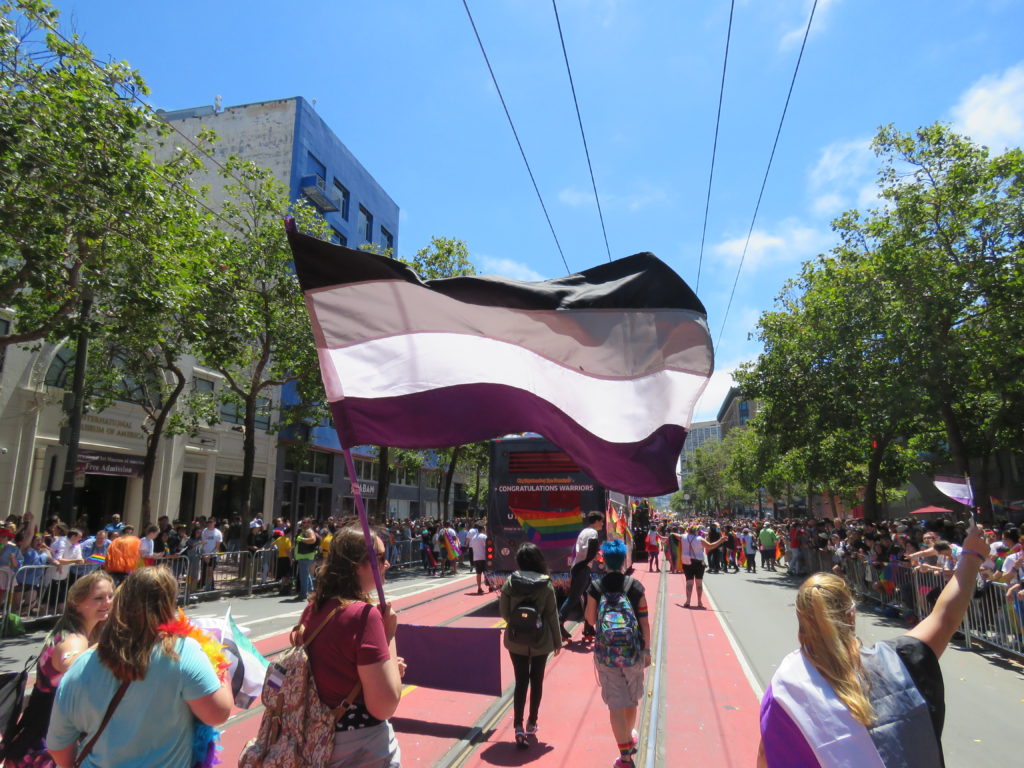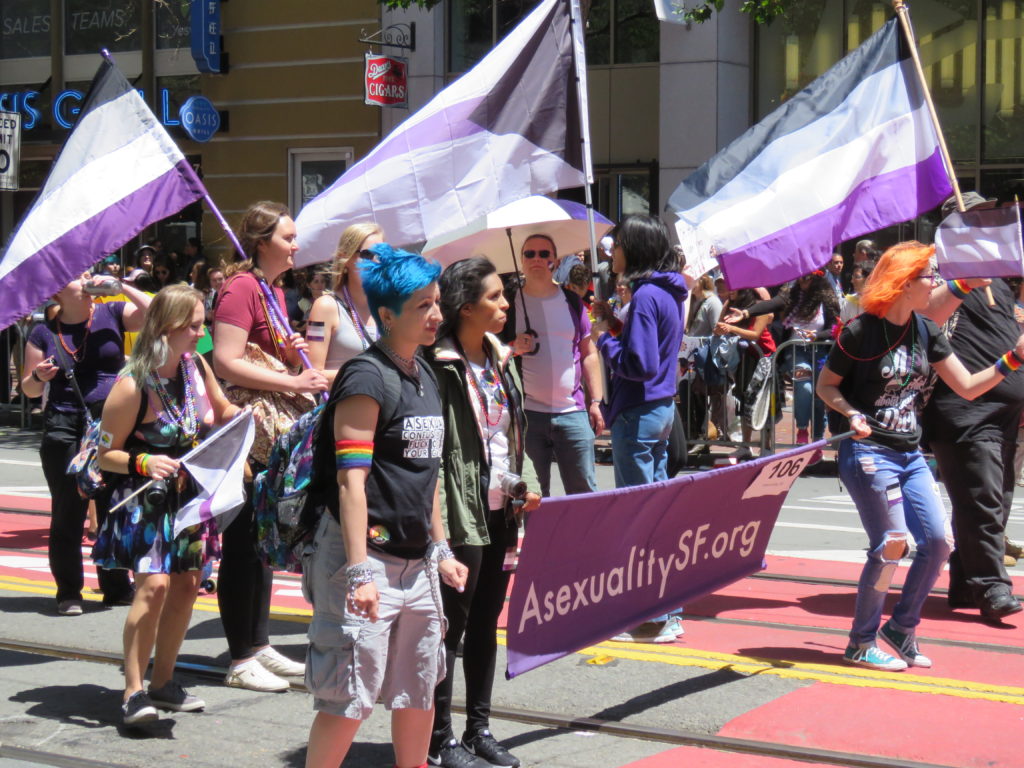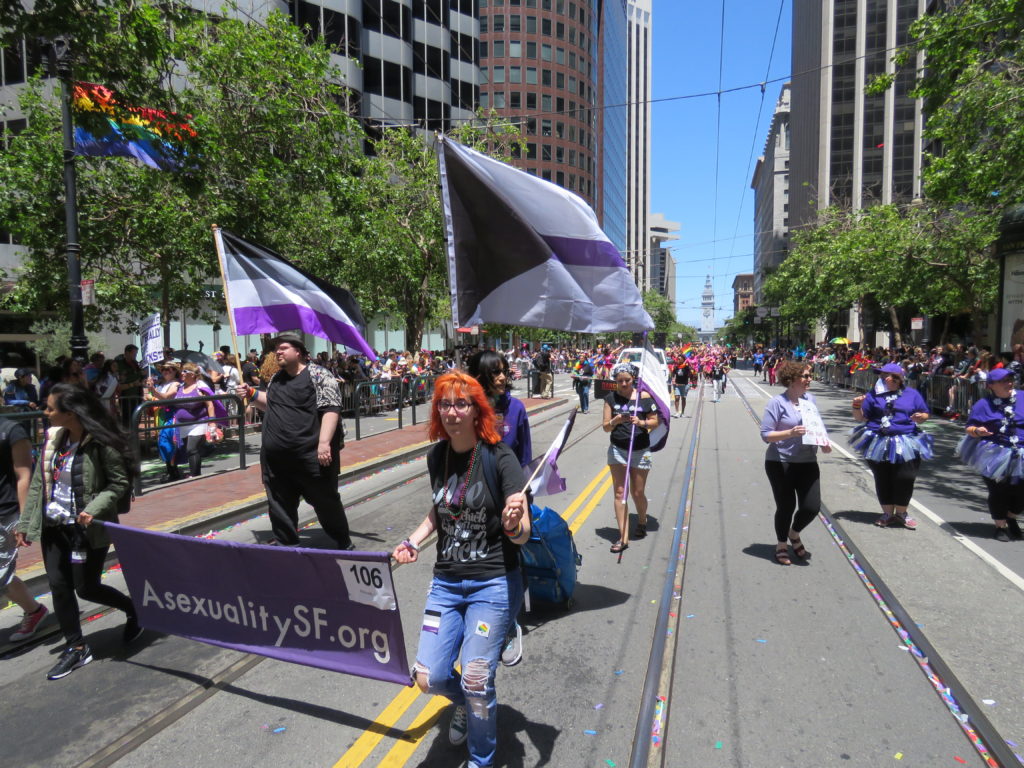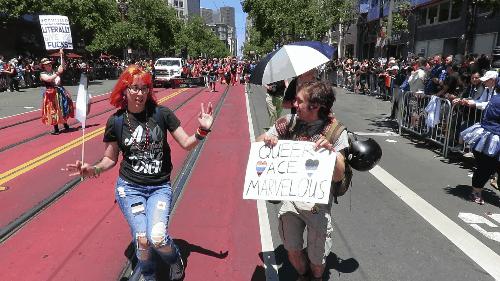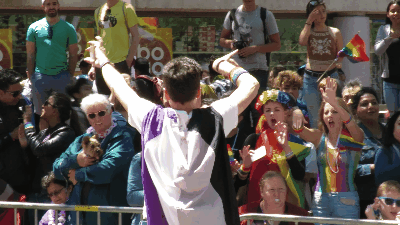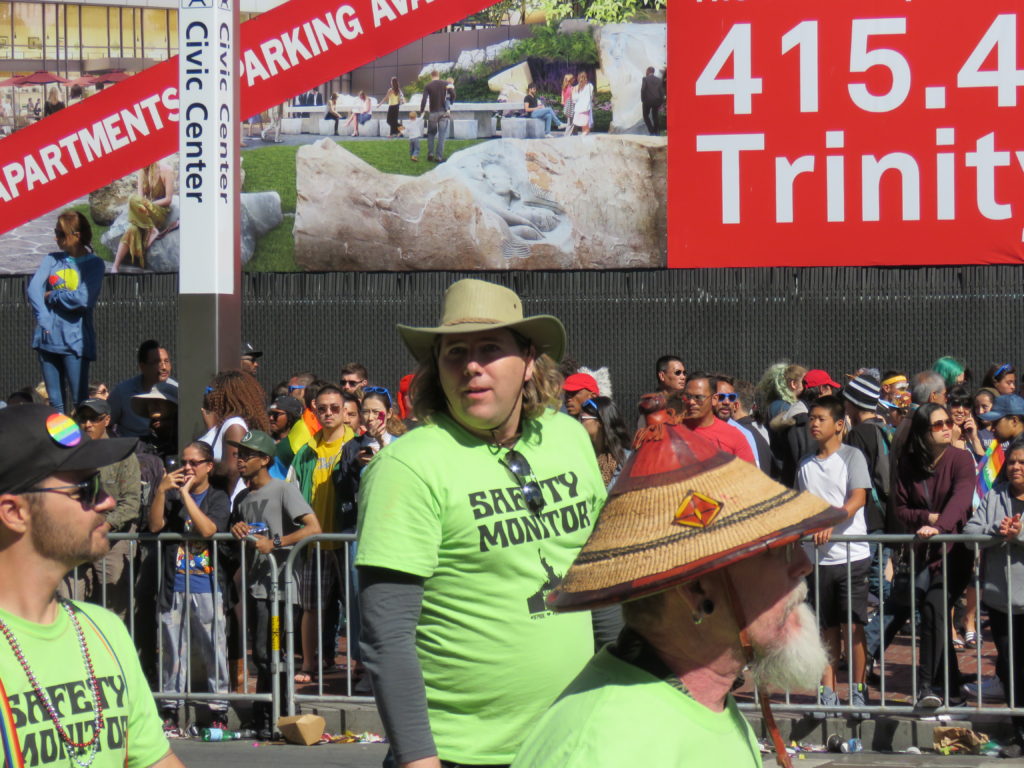I marched with Asexuality SF in the 2017 San Francisco Pride Parade. It was an amazing experience, and I’d like to share some of what I learned.
(I suppose this also counts as a submission to the July 2017 Carnival of Aces, since it’s about “Ace-ing it up Offline”…)
To get the full parade experience, please follow this link and start the song playing. Additional music cues will come later at the appropriate times.
Finding your group is important. I walked right by our marching group, which was squeezed in between a dance troupe and a tour bus. Make sure your group is visible. If possible, post pictures of your location on Facebook or Meetup or wherever else you’re organizing the march. I’d even consider using something like Glympse or some other location tracker, so people can just home in on your signal.
Be prepared to wait. We were told to arrive by 10 AM for an 11 AM step off. At around 11:15, the “Drivers to your vehicles and start your engines!” call came down the street. That was supposed to be the 15 minute warning. And so we waited. 15 minutes. 30 minutes. An hour. An hour and a half. We eventually started moving about two hours after that initial call, after having sucked on diesel exhaust from the tour bus for the whole time.
You group will probably be squeezed. Realistically speaking, your ace contingent won’t be the largest group around. The other groups in the area will start to take up more and more space. We were crammed between a tour bus, a dance troupe who kept growing members and decided to practice their dance moves in the middle of our group, and the literally thousand+ member Google contingent.
Please pause the continuous loop of “Raise Your Glass” at this time. The Oakland Fire Department requires you to dance the YMCA. Your participation is mandatory. You are at a Pride Parade, after all.
Good. Now please resume the endless loop of Raise Your Glass.
Be prepared to move fast. We were waiting waiting waiting. Waiting waiting. We lost a member to boredom. Wait wait wait. We’d sent out scouting parties to look at the other blocks, and they reported back that no one was moving. Then, as I was about to head up the block to see what was going on, our block suddenly began to move. I went back to our group, shouting “THE UNICORN JUST MOVED!”, and we scrambled to get lined up. The tour bus took off down the street, and we started walking. Then jogging. Then full-out sprinting, when a monitor told us to “Move faster!”. I don’t think we lost anyone in the scramble, but that was a real possibility. If someone had been in the bathroom, or wandering around the block, they would have been left behind.
Be prepared to wait. After we ran to the next block, we stopped again for a while, as the groups on the other side of the street moved their positions, too.
Please pause the continuous loop of “Raise Your Glass”. For the next bullet point, you must play Justin Timberlake’s “Can’t Stop The Feeling” as loud as possible.
It doesn’t matter once you roll. You turn that corner and start down the street full of screaming, cheering people, and all that waiting and running and waiting and everything else that came before just disappears. You are there and you are a part of something amazing for the next mile and a half.
I hope you went to the bathroom first. Now that you’re marching, it’s a bit late to bring this up, but there aren’t any bathrooms for at least the next hour. You’re also marching toward the crowds at the Pride Festival, so there’s probably going to be a line when you get there.
You may now resume the loop of “Raise Your Glass”.
Be prepared for the weather. When we first got to the staging area, it was 60 degrees, overcast, and occasionally misting. By the end, it was 70 and sunny. We had off and on wind the whole time. So bring sunscreen, jackets, umbrellas, water, whatever you expect you might need.
Have your water (and snacks) accessible. I had mine in my backpack, which seemed like a great place for it, until I decided I needed some. My backpack was on my back, under a flag cape, I had cameras and bags hanging off of me, and a pair of large flagpoles strapped to my chest. There was no way that was all coming off so I could get to the water while we were on the move. We had a rolling cart that was always available that was a good place to keep swag and water and stuff. (However, that means that the cart needs to the hauled along for the entire parade.)
You don’t stop. Once the parade gets moving, you’re on a conveyor belt. You can’t stop. If you do, you’ll be in the way of the dance group behind you, and they’ll expect you to take part in their marching dance to Michael Jackson’s Black Or White, and you may never get back to your marching group. Now, it’s not entirely true that you never stop, but you have no idea how long you’re going to be stopped, but it’s never for very long, and you’d better be ready to move when the tour bus in front of you takes off again.
Take pictures.
Take lots of pictures.
No, seriously, take a lot of pictures. One person in your group should act as a designated photographer and spend the entire time circling your group, taking tons of photos of the dancing and flag-waving and videos of the singing. It’s great if everyone is taking occasional phone snaps of what’s going on, but make sure that it’s someone’s job that pictures get taken. (And make sure that photographer has extra batteries and memory cards handy.)
And then share those pictures everywhere you can. The point of being at a pride parade is to be visible, and you should work to extend that visibility beyond just the audience of the parade. It’s one thing to say “Yes, we marched in Pride”, but it’s an entirely different matter to show a dozen pictures so people can see that you were there. Live blog some of it, if you can.
Please pause the continuous loop of “Raise Your Glass”. The tour bus in front of you has started blasting Icona Pop’s “I Love It”, which contains the refrain “I! DON’T! CARE!” and turns out to be a perfect ace pride anthem.
See what I was saying about pictures and videos?
You may now resume the loop of “Raise Your Glass”.
Put someone on roller skates, give them a flag cape, and have them dance around for the entire length of the parade. Seriously, just do it.
Come decked out in an ace or aro getup. People love costumes, and it can really help drive the sense of community, if people are wearing the flag colors or an ace t-shirt.
Come as you are. If you don’t want to get dressed up, don’t worry about it. Come as you are. Just being there is important.
Have a few catchy slogans on signs. We had someone with a sign that read “Asexuals Literally Give No Fucks”, and that sign caught a lot of people’s attention. They took pictures of that sign and put it up on Twitter, and people on Twitter retweeted it. Extra visibility for free!
Bring flags. Large flags. Medium flags. Small flags. Flag stickers. Flags worn as capes. Everyone in your group should have access to a flag or two if they want it. Flags are important for visibility. Even if they don’t see your t-shirt or your banner, they’ll see your flag. And be sure to have multiple kinds of flags. I made sure we had a demi flag and an aro flag on display. Someone in the crowd screamed “OH MY GOD!! AN ARO FLAG!!” when they saw me. Speaking of which…
You matter to someone in the crowd. You matter. What you’re doing is important. Someone out there will see you and discover who they are. I’ve heard stories of people who didn’t know what asexuality was until they saw an ace group in a pride parade and decided to research it. Someone out there will see you and know that they’re valid, that asexuality is real. You will change someone’s life.
Someone in the crowd is important to you. You’ll see someone in the crowd get excited as you pass, and you’ll know that what you’re doing matters. You’ll know that you’re not just walking down the street for no particular reason.
Show up. I’m socially anxious and heavily introverted and I managed to pull it off. Once you’re out there, you can actually mostly tune out the people (They sort of all turn into a noisy fence after a while.) and just walk along, if you need to. If you don’t want to wave or interact with parade goers, carry the sign or haul the wagon or take the pictures, do some other job, so you’re there, but kept occupied. The more people who show up, the better, and that includes you being there. Someone else will do all the dancing and singing, so don’t worry about it.
Bring swag to hand out. We had a bunch of stickers that we were handing out. It seemed like we needed several levels of swag. Generic, cheap-o stuff for the people who were just grabbing at anything over the fence, and specific awesome ace swag for the people who were actually excited to see us. I wish I’d had the presence of mind to give an aro flag to the person who screamed about mine. I wish I’d been able to reach the person with the ace flag sign to hand them a wrist band and a button.
We have reached the end of the parade route. Please keep right, turn off your music, and do not stop until you are out of the fenced in area. Thank you.
Be prepared for assholes. You’ll probably encounter a few along the way. It’s unlikely you’ll meet someone who is acephobic specifically. Those people tend to only inhabit dark, smelly corners of the Internet and never come out into daylight. However, you may run into garden variety ignorance, where people have no idea what asexuality is, no interest in learning about it, they just know that whatever it is, they don’t like it and don’t understand why we’re there. One of our marchers was actually even pulled aside by one of the official parade safety monitors, who demanded to know what we were doing there and who let us march.
Fuck you, buddy. Your boss let us march in the parade. And we’re here to fight against ignorant dumbshits like you.
We belong here. That’s the most important thing to remember. WE BELONG. Asexuality is a real and valid sexual orientation. It’s invisible. It’s marginalized. It’s looked down upon. We’re not going to hide anymore. We’re not going to told that we’re broken anymore. We’re not going to be told that we don’t belong. We are here to be seen. The rainbow flag is ours. Pride is ours.
So just do it. Next year, get out there and march.

